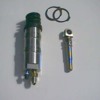Ever since I bought my pantera I have had grinding issues with my trans. I have had the trans rebuilt, replaced the clutch, pressure plate and throw out bearing with the "proper" parts. I want to replace my master and slave cylinder with a long throw slave. I have bled the system and every time the fluid looks really dirty. (I think the master cylinder has some issues.) Could anyone tell where would be the best place to purchase a master cylinder and a long throw slave? Thanks in advance.
Original Post



